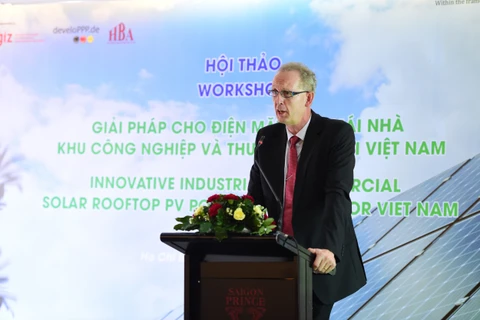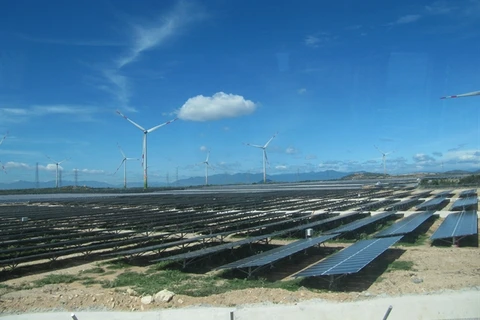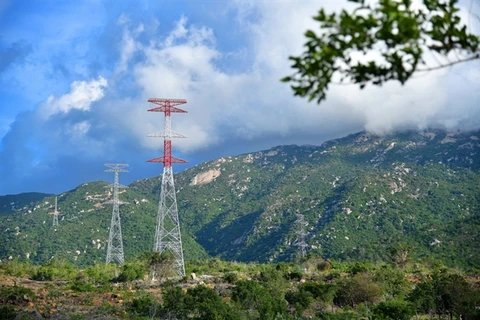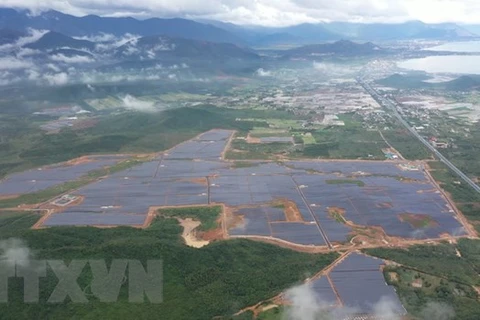Hanoi (VNS/VNA) - Nguyen Duc Ninh, Director of the National Power Regulation Centre, has said Vietnam will cut its renewable electricity capacity due to oversupply.
Ninh told local media at a recent conference of the Vietnam Electricity Group (EVN) that Vietnam will cut 1.3 billion KWh of renewable energy in 2021.
According to EVN's statistics, national electricity output generated from solar power in 2020 was 10.6 billion kWh, including 1.15 billion kWh from rooftop solar power, accounting for about 4.3 percent of the total output from the national electricity system.
Ninh said in 2020, the regulating agency must reduce 365 million kWh of unexploited solar power due to overloads of local networks, mainly in central provinces like Ninh Thuan and Binh Thuan.
By the second half of November 2020, due to the excess power from the growth of solar farms and solar rooftop power, the electricity industry had to make a total reduction of 35 million kWh.
In 2017, the Government issued the first feed-in tariff (FIT) mechanism with the purchase price of solar power for all types of 9.35 cents per kWh, until June 30, 2019, leading to many solar power projects being licensed rapidly.
In June 2020, the Government moved to a FIT 2 tariff of 7.09 cents per kWh for solar power on the ground, 7.69 cents for floating solar power, and 8.38 cents per KWh 7.69 cents for rooftop power. On December 31, 2020, the decision expired and investors must await a new tariff.
Pham Que Phong, Chairman of the Inter Solar Joint Stock Company, said: “If the upcoming FIT 3 price is issued to prioritise dispersed solar rooftop and has a price difference between regions according to the rate of radiation, it will promote lots of rooftop solar projects and limit solar farm projects."
"The loose management has led to the fact that the majority of solar rooftop projects are actually now solar farms," he said.
Phong said the country was estimated to have more than 100,000 rooftop solar power projects with a total output of nearly 10,000 MWp but only 20 percent of them were rooftop solar power constructions and installed on the roofs of offices, restaurants and hotels.
He said the rest were solar farm projects disguised as rooftop solar power to enjoy the price of 8.38 cents per kWh instead of 7.09 cents per kWh for solar farms.
Phong predicted the buying price of rooftop solar power would decrease this year following the trend in the world, adding: “The reduction will not be much.”
"Households, businesses and administrative agencies with solar roof power should not worry as though the price of electricity is cheaper, the initial investment cost is also cheaper," he said.
Regarding the FIT prices of solar power, some companies believed that the adjustment of the annual price was reasonable because the prices of solar technology and equipment in the world were declining.
Professor Bui Thien Du, a former lecturer of the Electrical Faculty of Hanoi University of Technology, said: “The country needs to build a long-term, transparent solar power development policy roadmap towards protecting the interests of investors, especially local users who have installed solar power at home.”
"In addition to the households that install roofs for use, the rest want a stable policy to sell electricity to quickly recover capital. Therefore, for rooftop solar projects, it is necessary to have a separate sustainable mechanism to ease the users and investors’ concern. The Government and the Ministry of Industry and Trade should carefully calculate to not repeat the problems that arose in the past with a seamless policy," he said.
"Cutting the solar power is not reasonable, they must find solutions to solve problems and develop sustainable renewable energy instead," he said.
"It is necessary to solve the problem of transmission infrastructure by attracting resources, allowing the private participation while the State manages the capital recovery mechanism for investors, releasing capacity while ensuring the energy and national security," Du added.
He said the sustainable development of renewable electricity should follow strict controls and requires good investment in transmission infrastructure.
Ninh said they need to adjust the generating time of small hydroelectricity, avoiding frame from 11am to 1pm, which was the best solar radiation time for rooftop solar.
Ninh asked the Government and the MoIT for mechanisms and principles to mobilise renewable energy sources when the system was redundant or overloaded, adding the centre was now confused about mobilising different sources.
Du told local media: “A lack of vision in the solar development and matters in transmission grid has resulted in the incomplete capacity of solar electricity.”
He added the mechanisms and policies on solar development had been unsustainable and brought risks to investors and the people.
Du again said Vietnam has to build a long-term and transparent solar power development policy roadmap to improve its power industry./.
Ninh told local media at a recent conference of the Vietnam Electricity Group (EVN) that Vietnam will cut 1.3 billion KWh of renewable energy in 2021.
According to EVN's statistics, national electricity output generated from solar power in 2020 was 10.6 billion kWh, including 1.15 billion kWh from rooftop solar power, accounting for about 4.3 percent of the total output from the national electricity system.
Ninh said in 2020, the regulating agency must reduce 365 million kWh of unexploited solar power due to overloads of local networks, mainly in central provinces like Ninh Thuan and Binh Thuan.
By the second half of November 2020, due to the excess power from the growth of solar farms and solar rooftop power, the electricity industry had to make a total reduction of 35 million kWh.
In 2017, the Government issued the first feed-in tariff (FIT) mechanism with the purchase price of solar power for all types of 9.35 cents per kWh, until June 30, 2019, leading to many solar power projects being licensed rapidly.
In June 2020, the Government moved to a FIT 2 tariff of 7.09 cents per kWh for solar power on the ground, 7.69 cents for floating solar power, and 8.38 cents per KWh 7.69 cents for rooftop power. On December 31, 2020, the decision expired and investors must await a new tariff.
Pham Que Phong, Chairman of the Inter Solar Joint Stock Company, said: “If the upcoming FIT 3 price is issued to prioritise dispersed solar rooftop and has a price difference between regions according to the rate of radiation, it will promote lots of rooftop solar projects and limit solar farm projects."
"The loose management has led to the fact that the majority of solar rooftop projects are actually now solar farms," he said.
Phong said the country was estimated to have more than 100,000 rooftop solar power projects with a total output of nearly 10,000 MWp but only 20 percent of them were rooftop solar power constructions and installed on the roofs of offices, restaurants and hotels.
He said the rest were solar farm projects disguised as rooftop solar power to enjoy the price of 8.38 cents per kWh instead of 7.09 cents per kWh for solar farms.
Phong predicted the buying price of rooftop solar power would decrease this year following the trend in the world, adding: “The reduction will not be much.”
"Households, businesses and administrative agencies with solar roof power should not worry as though the price of electricity is cheaper, the initial investment cost is also cheaper," he said.
Regarding the FIT prices of solar power, some companies believed that the adjustment of the annual price was reasonable because the prices of solar technology and equipment in the world were declining.
Professor Bui Thien Du, a former lecturer of the Electrical Faculty of Hanoi University of Technology, said: “The country needs to build a long-term, transparent solar power development policy roadmap towards protecting the interests of investors, especially local users who have installed solar power at home.”
"In addition to the households that install roofs for use, the rest want a stable policy to sell electricity to quickly recover capital. Therefore, for rooftop solar projects, it is necessary to have a separate sustainable mechanism to ease the users and investors’ concern. The Government and the Ministry of Industry and Trade should carefully calculate to not repeat the problems that arose in the past with a seamless policy," he said.
"Cutting the solar power is not reasonable, they must find solutions to solve problems and develop sustainable renewable energy instead," he said.
"It is necessary to solve the problem of transmission infrastructure by attracting resources, allowing the private participation while the State manages the capital recovery mechanism for investors, releasing capacity while ensuring the energy and national security," Du added.
He said the sustainable development of renewable electricity should follow strict controls and requires good investment in transmission infrastructure.
Ninh said they need to adjust the generating time of small hydroelectricity, avoiding frame from 11am to 1pm, which was the best solar radiation time for rooftop solar.
Ninh asked the Government and the MoIT for mechanisms and principles to mobilise renewable energy sources when the system was redundant or overloaded, adding the centre was now confused about mobilising different sources.
Du told local media: “A lack of vision in the solar development and matters in transmission grid has resulted in the incomplete capacity of solar electricity.”
He added the mechanisms and policies on solar development had been unsustainable and brought risks to investors and the people.
Du again said Vietnam has to build a long-term and transparent solar power development policy roadmap to improve its power industry./.
VNA

























